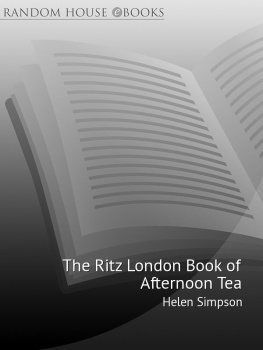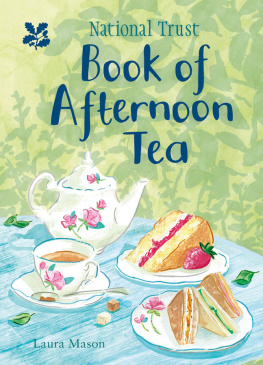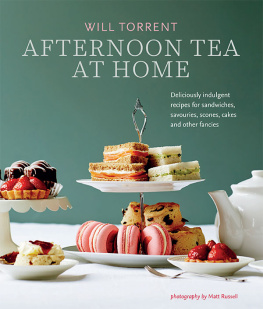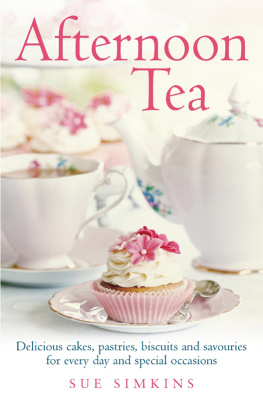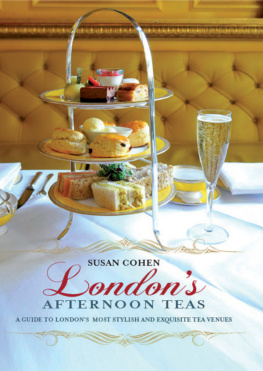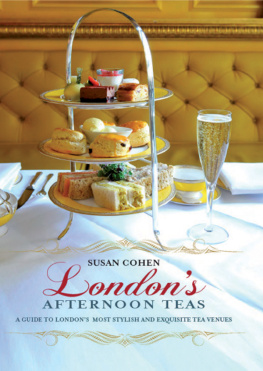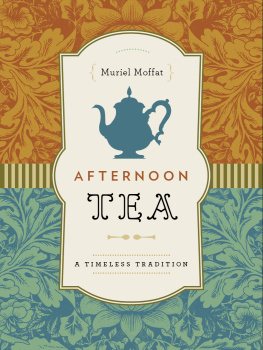Contents
To Richard
Tea! Thou soft, thou sober, sage, and venerable liquid, thou female tongue-running, smile-smoothing, heart-opening, wink-tipping cordial, to whose glorious insipidity I owe the happiest moment of my life, let me fall prostrate.
Colley Cibber, The Ladys Last Stake, 1708
Note on flour for those using Cup Measures
All purpose flour can be substituted for cake flour, although this may not give such fine results.
About the Book
Taking tea is one of the quintessentially English occasions and The Palm Court Tearoom at The Ritz London has historically been one of the most delightful places to experience the tradition at its best.
The Ritz Book of Afternoon Tea provides the reader with all the Ritz expertise in the ceremony of taking tea, as well as the recipes. Stories about Csar Ritz and the legendary teas at his hotel are wonderfully enhanced by the immortal words of Dickens, Oscar Wilde and many more. Over fifty recipes are included from strawberry shortcake, rose-petal jam and scones to muffins, crumpets and fruit cake.
This charming book captures the magic of afternoon tea at The Ritz London, and the wonderful recipes for every tea-time occasion make it a delicious morsel of Edwardian London.
Tea at the Ritz
TEA AT THE Ritz is the last delicious morsel of Edwardian London. The light is kind, the cakes are frivolous and the tempo is calm, confident and leisurely. Takers of tea perch on rose-coloured Louis XVI chairs at marble tables, sipping their steaming cups of Darjeeling or Earl Grey, while the belle poque nymphs look on in Olympian disdain.
The Ritzs stage for afternoon tea is The Palm Court, separated from the ground floors central gallery by Ionic columns. There are no clocks, and, although it is just possible to glimpse the flash of Piccadillys taxis and buses if you look hard in the direction of the swing doors, a strange sense of taking a holiday from time heightens the pleasure of taking tea here. People look more beautiful than they do in real life, as this is the most flattering light in Europe, falling mild and clear from The Palm Courts frosted glass ceiling and pink-capped chandeliers.
Csar Ritz always maintained that nothing put people more at their ease in his hotels than the blandishment of tactful lighting. His widow described in her biography of her husband: For weeks Ritz was absorbed in lighting problems. And for hours and hours at a time I would sit while he and an electrician tried the effects of various coloured shades on my complexion! A delicate apricot-pink was found to be the most becoming colour.
Holding sway over this rose-tinted afternoon tea is the famous nymph of The Palm Court fountain, young tritons blowing conch shells above her, while at her feet a tribe of goldfish flick their tails. Anthony Powell described her in A Dance to the Music of Time: Although stark naked, the nymph looked immensely respectable; less provocative, indeed, than some of the fully dressed young women seated below her.
Lady Diana Cooper remembers The Ritz as the first hotel where young women were allowed to go alone to tea. Romantic novelist Barbara Cartland has described tea at The Ritz in the years after the First World War as a useful institution for the also-ran men: one could meet men, without chaperones, for lunch and tea, so you had lunch with men you were keen on, and tea with the rest.
A few years ago tea at The Ritz reached such dizzy heights of popularity that there would be crowds milling around on the Savonnerie carpet at the steps of The Palm Court, waiting for a table. This could not be allowed, and now it is necessary to reserve tea at The Ritz. Here is one of the few places outside church or royal garden parties where a woman may wear a hat and feel entirely at ease. In fact, those approaching The Palm Court clad in such garments as jeans, shorts or sneakers will be reluctantly but firmly turned away. Suitably dressed tea-bibbers, however, will be greeted by The Palm Courts waiters, many of whom have worked at the Ritz for a number of years now. Tea at the Ritz is not only sandwiches and cakes but an Occasion, he says. Thank goodness there are still places like this for pure enjoyment, even in the modern world.
Sandwiches
Tea at The Ritz, arriving on beautiful china, starts with sandwiches, each crustless finger striped with one of half-a-dozen constant fillings. Down in The Ritz kitchens, it takes the sandwich chef a number of hours to provide the afternoons supply. Extra long loaves are delivered and then sliced lengthwise in twelve giant strata. Each stratum is spread with softened butter, using a broad spatula knife. Then the fillings are added. Two long slices of brown are placed on top of two long slices of white, and so on, until six great horizontal sandwiches appear in an unbroken wall.
Tea sandwich fillings may include: thinly sliced cucumber (); finely grated cheddar cheese, which are generally served on white bread.
At the end of this procedure with the long loaves, the crusts are shaved from them with a fourteen-inch knife with a serrated blade.
The long bread wall is then sliced at one-inch intervals to produce a multitude of neat stacks of finger sandwiches.
Scones
Next come scones, plain risen little cakes to eat with cream and jam (). The Ritz scones are not baked until early afternoon on the day on which they are to be served to make sure they are as fresh as possible.
and Cakes
Cakes and pastries at a Ritz afternoon tea are airy and Frenchified, extremely pretty, creamy and rich. Crisp shells of pte sucre, choux and puff pastries are filled with whipped cream and embellished with feather-patterned fondant icing or thin slices of sweet fruit. The Head Pastry Chef and his staff produce a fresh fleet of these cakes every day.
MILLE FEUILLES
These intricate and exquisite pastries need time, patience and delicate handling in their assembly for perfect results. It is wise to remember that puff pastry can be bought frozen or chilled, and gives excellent results. There is a recipe for those who prefer to make their own. Bought fondant can be used if you prefer.
Next page
